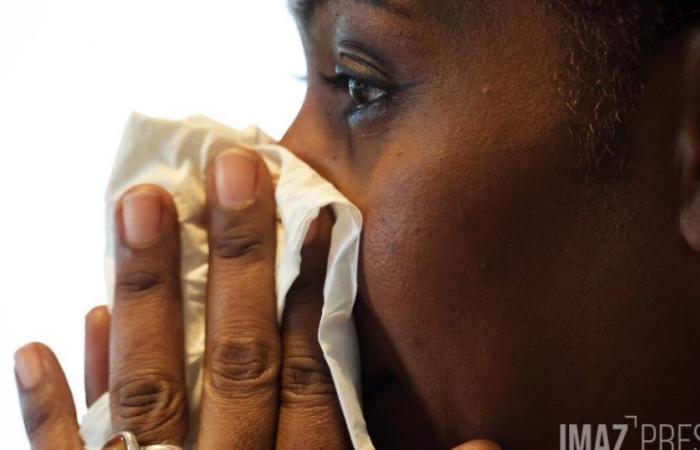This Friday, September 27, 2024, Public Health France publishes the epidemiological update. If seven cases of chikungunya have been confirmed, it is the increase in respiratory infections, bronchiolitis, gastro and cases of Covid which is of concern. All indicators are on the rise and virus circulation continues to intensify (Photo: www.imazpress.com)
– Acute respiratory infection and influenza viruses –
Visits to the emergency room due to influenza-like illness increased in week 38 compared to the previous week.
In W38, emergencies recorded 36 visits for reasons of flu syndrome versus 26 in W37. The number of hospitalizations for influenza-like illness remained stable with only 5 hospitalizations reported in W38 compared to 3 in W37.
The share of emergency activity for influenza reasons represented less than 1% of total activity.
In community medicine, the share of activity in Acute Respiratory Infections (ARI) continues to increase with 6.4% of total activity in W38 versus 5.6% of total activity in W37. The share of activity for IRA was above the level of the 2013-2023 average.
Virological surveillance in W38 identified a moderate increase in the circulation of influenza viruses with a majority of circulation of influenza type A(H1N1)pdm09. The positivity rate represented 11% of positive tests for influenza viruses in W38, an increase compared to W37 (8%).
Read also – Faced with “small” viruses and bacteria, medications can make you (even) sicker
– Bronchiolitis (in children under 2 years old) –
Visits to the emergency room due to bronchiolitis in children under 2 years old were up in W38 compared to the previous week. In W38, 35 children aged under 2 years consulted the emergency room for bronchiolitis compared to 20 in W37.
New hospitalizations were up (n=11) compared to the previous week (n=7).
The share of visits to the emergency room for bronchiolitis among all visits of children under two years old was increasing with 9.6% of activity in W38 compared to 6.6% for W37.
Concerning virological surveillance, no positive result for RSV was identified in W38 as in W37
– Acute gastroenteritis (GEA) –
In W38, visits to emergency departments of all ages for reasons of gastroenteritis were increasing (+11%). The number of visits to the emergency room was 101 in W38 versus 91 in W37. The number of hospitalizations, however, was down moderately with 10 hospitalizations in W38 compared to 15 in W37.
In children under 5 years old, visits to the emergency room for reasons of gastroenteritis remained stable in week 38 (n=51) compared to week 37 (n=48). Hospitalizations after a visit to the emergency room, on the other hand, were down with 6 hospitalizations in W38 versus 11 in W37.
In W38, the share of emergency activity among those under 5 years old for gastroenteritis decreased compared to the previous week (8.4% in W37 vs 9.5% in W37).
In community medicine, the share of activity for acute diarrhea had been increasing continuously for 4 weeks and stood at 3.3% in W38 versus 2.8% in W37. It remained above the level of the average for the years 2013-2023.
– COVID-19 –
In W38, emergency room consultations for COVDI-19 reasons were on the rise. In W38, 20 patients consulted the emergency room due to COVID-19 versus 12 patients the previous week. Hospitalizations were stable with 10 new hospitalizations for COVID-19 in W38 versus 8 in W37.
Virological surveillance implemented with virology data from the CHU microbiology laboratory (CNR Arbovirus Associated, CNR Respiratory Virus Associated, Reunion) shows a decreasing Positivity Rate (PT) of COVID-19 in W38 compared to the S37. There were 14 positive tests among 182 tests in S38, i.e. a TP of 7.7% vs. 18 positive tests among 198 tests in S37, i.e. a TP of 9.1%.
– Chikungunya –
Since August 23, several confirmed cases of indigenous chikungunya have been reported in Reunion. To date, 7 cases have been confirmed and one case ruled out by the Associated National Reference Center for Arboviruses (CNRa). Among these cases, 6 are grouped together in a focus in Saint Gilles les Bains. One case for which no link could be established was identified at the Hermitage.
The ARS vector control agents undertook measures around each of these cases to prospect for larval breeding sites, insecticide treatment, raise awareness and search for suspected cases in the area concerned in order to reduce the risk of infection. installation of an indigenous circulation.
Targeted information was also sent to all healthcare professionals.
The current period, the end of the southern winter, is characterized by a still limited vector density, but the arrival of conditions more favorable to vector activity encourages all stakeholders to be extremely vigilant.
In this context, we invite medical personnel to prescribe a biology allowing the confirmation or denial of the diagnosis in any patient who presents with a flu-like syndrome with joint pain.
The recommended diagnostic strategy is as follows:
PCR, to be carried out within the first 8 days, is the reference diagnostic test. Therefore, the patient should be encouraged to carry out confirmatory biology as soon as possible after the appearance of symptoms. Indeed, seroconversion (appearance of IgG in a second sample taken more than 10 days from the first) also makes it possible to confirm the infection but at a distance from the onset of symptoms.
Chikungunya virus infection is considered immunizing: in cases where early serology (
Between 2005 and 2006, Reunion experienced 2 successive epidemic waves of chikungunya virus infections, including one of massive scale in the summer of 2006. Data at the time estimated that 38% of the Reunion population had been affected by this epidemic (i.e. more than 250,000 cases in a population of 700,000 inhabitants at the time).
Traffic had affected the entire island – with the exception of Cilaos and the communes of Ste Rose and St Benoit, which were more modestly affected.
Although chikungunya is a pathology generally of moderate severity – although with potential chronic joint pain – a certain number of atypical and/or serious forms have been described in Réunion. Thus “A retrospective and prospective census was conducted in the four hospitals on the island. Between March 2005 and April 2006, 44 maternal-neonatal cases and 834 atypical cases including 247 (30%) serious cases, as well as 68 deaths were recorded. Atypical forms represented 0.35% of chikungunya cases in the population. The most frequent clinical manifestations of atypical cases were digestive and neurological manifestations.
Atypical cases mainly occurred in vulnerable subjects (young children, elderly people, patients with a medical history). These results indicated the need to formulate prevention recommendations primarily for the attention of these subjects and pregnant women during a chikungunya epidemic. » From the BEH thematic 38-39-40 / October 21, 2008
Since the infection is considered immunizing, it is reasonable to believe that residual but unquantified immunity exists in the population. However, caution is required: given the natural replacement (deaths, births & migrations) of part of the population in 18 years, the territory remains vulnerable to a potential epidemic.
Surveillance of COVID-19 in emergency departments
– Mortality from all causes –
In S36, the number of deaths observed for all ages and all causes was 109 people. Compared to the previous week, the number of deaths observed was stable (n=107 in W35). The number of deaths observed in W36 was lower than the expected number of deaths (n=112).
Among those over 65, the number of deaths observed in W36 (n=82) was lower than the expected number of deaths (n=85).
This figure was stable compared to what was observed in S35 (84 deaths observed)
News from Reunion, Health, Flu, Virus






